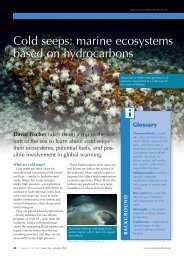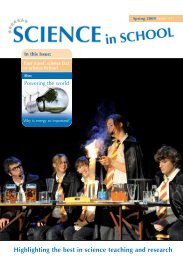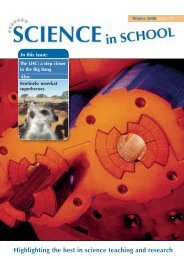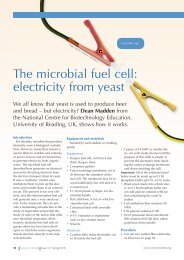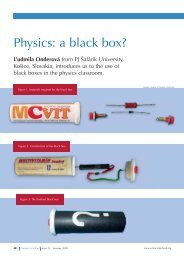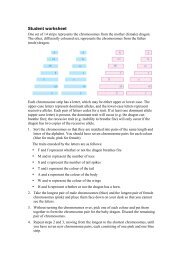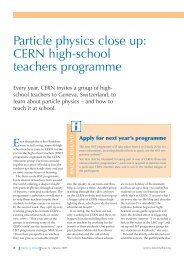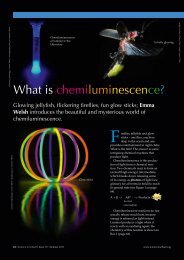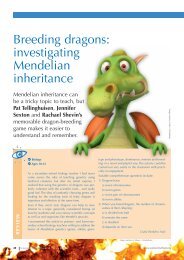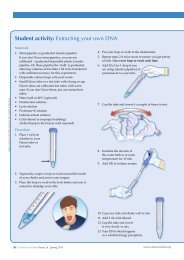Harnessing the power of the Sun: fusion reactors - Science in School
Harnessing the power of the Sun: fusion reactors - Science in School
Harnessing the power of the Sun: fusion reactors - Science in School
Create successful ePaper yourself
Turn your PDF publications into a flip-book with our unique Google optimized e-Paper software.
<strong>Science</strong> topics<br />
Image courtesy <strong>of</strong> EFDA-JET<br />
Figure 1: A <strong>fusion</strong> <strong>power</strong> plant will fuse tritium (two neutrons, blue,<br />
one proton, red) and deuterium (one neutron, one proton) nuclei,<br />
generat<strong>in</strong>g a helium-4 nucleus and a highly energetic neutron<br />
Scientists at Europe’s largest <strong>fusion</strong><br />
experiment, <strong>the</strong> Jo<strong>in</strong>t European Torus<br />
(JET) <strong>in</strong> Culham, UK, have been<br />
mak<strong>in</strong>g significant progress towards<br />
<strong>fusion</strong> energy for more than 30 years.<br />
None<strong>the</strong>less, <strong>the</strong> JET experiment still<br />
requires more <strong>power</strong> than it generates<br />
– which is not good for a <strong>power</strong> plant.<br />
The next step will be <strong>the</strong> <strong>in</strong>ternational<br />
experiment ITER, due to be switched<br />
on <strong>in</strong> 2019. ITER is expected to be <strong>the</strong><br />
first to produce a net <strong>power</strong> surplus –<br />
500 megawatts from a 50 megawatts<br />
<strong>in</strong>put (see Warrick, 2006). This would<br />
prove that <strong>fusion</strong> <strong>power</strong> plants are<br />
viable.<br />
So how does <strong>fusion</strong> work?<br />
To achieve <strong>fusion</strong> on Earth, scientists<br />
picked <strong>the</strong> most efficient reaction<br />
that takes place <strong>in</strong> <strong>the</strong> <strong>Sun</strong> – <strong>the</strong> <strong>fusion</strong><br />
<strong>of</strong> two isotopes <strong>of</strong> hydrogen: deuterium<br />
and tritium. This reaction yields<br />
a helium-4 nucleus and a neutron,<br />
which carries 80% <strong>of</strong> <strong>the</strong> <strong>fusion</strong> energy<br />
(Figure 1). These fast neutrons are<br />
captured <strong>in</strong> <strong>the</strong> steel wall <strong>of</strong> <strong>the</strong> <strong>fusion</strong><br />
reactor, which transfers <strong>the</strong> heat to<br />
cool<strong>in</strong>g fluids with<strong>in</strong> <strong>the</strong> wall, which<br />
<strong>in</strong> turn drive a turb<strong>in</strong>e to produce<br />
electricity.<br />
The <strong>fusion</strong> device<br />
Currently, <strong>the</strong> most advanced type<br />
<strong>of</strong> <strong>fusion</strong> device is <strong>the</strong> tokamak. At<br />
<strong>the</strong> heart <strong>of</strong> a tokamak is <strong>the</strong> reactor, a<br />
r<strong>in</strong>g-shaped steel vessel with numerous<br />
open<strong>in</strong>gs for heat<strong>in</strong>g, measurement<br />
and o<strong>the</strong>r systems, and an <strong>in</strong>ner<br />
wall l<strong>in</strong>ed with removable heat-resistant<br />
tiles (Figure 2). To start <strong>the</strong> <strong>fusion</strong><br />
process, <strong>the</strong> vessel is subjected to high<br />
vacuum – at JET, this value is around<br />
0.00000001 millibar – and a few grams<br />
<strong>of</strong> deuterium and tritium gas are<br />
<strong>in</strong>jected. The gas is heated to above<br />
10 000 °C, at which po<strong>in</strong>t <strong>the</strong> electrons<br />
Image courtesy <strong>of</strong> EFDA<br />
Figure 2: Cutaway diagram <strong>of</strong> <strong>the</strong> tokamak JET show<strong>in</strong>g <strong>the</strong> steel vessel<br />
surrounded by eight large copper coils, which produce <strong>the</strong> magnetic<br />
fields. Note <strong>the</strong> person on <strong>the</strong> left to give an <strong>in</strong>dication <strong>of</strong> size<br />
REVIEW<br />
Physics<br />
Interdiscipl<strong>in</strong>ary<br />
Environmental science<br />
Energy production<br />
Fusion<br />
Susta<strong>in</strong>ability<br />
Ages 10-19<br />
This article describes <strong>the</strong> research<br />
<strong>in</strong>to produc<strong>in</strong>g electrical<br />
energy by <strong>the</strong> <strong>fusion</strong><br />
<strong>of</strong> light atomic nuclei – just<br />
as <strong>the</strong> <strong>Sun</strong> does. It <strong>of</strong>fers<br />
physics or science teachers<br />
a detailed overview <strong>of</strong> how<br />
<strong>fusion</strong> works, and what <strong>the</strong><br />
challenges are to produc<strong>in</strong>g<br />
energy <strong>in</strong> a <strong>fusion</strong> <strong>power</strong><br />
plant.<br />
The issues <strong>of</strong> climate change<br />
and <strong>the</strong> greenhouse effect<br />
mean that many countries<br />
have to solve <strong>the</strong> problem<br />
<strong>of</strong> how to produce renewable<br />
energy <strong>in</strong> a susta<strong>in</strong>able<br />
way. This article <strong>the</strong>refore<br />
could be useful not only for<br />
physics lessons, but also for<br />
biology, geography and language<br />
lessons.<br />
The article would stimulate<br />
discussion around a broad<br />
range <strong>of</strong> questions, <strong>in</strong>clud<strong>in</strong>g:<br />
· How does <strong>fusion</strong> work?<br />
· Why, even after 30 years<br />
<strong>of</strong> research, are we not yet<br />
produc<strong>in</strong>g energy from <strong>fusion</strong><br />
<strong>power</strong> plants? What<br />
are <strong>the</strong> challenges?<br />
· What could be <strong>the</strong> advantages<br />
<strong>of</strong> us<strong>in</strong>g <strong>fusion</strong> <strong>reactors</strong>?<br />
· Is <strong>the</strong> production <strong>of</strong> energy<br />
by <strong>fusion</strong> susta<strong>in</strong>able?<br />
Gerd Vogt, Higher Secondary<br />
<strong>School</strong> for Environment<br />
and Economics, Yspertal,<br />
Austria<br />
www.science<strong>in</strong>school.org<br />
<strong>Science</strong> <strong>in</strong> <strong>School</strong> I Issue 22 : Spr<strong>in</strong>g 2012 I 43





